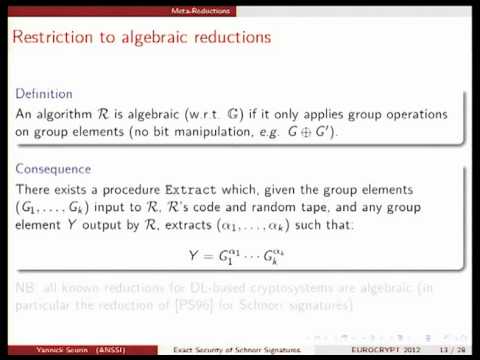Welcome to the resource topic for 2012/029
Title:
On the Exact Security of Schnorr-Type Signatures in the Random Oracle Model
Authors: Yannick Seurin
Abstract:The Schnorr signature scheme has been known to be provably secure in the Random Oracle Model under the Discrete Logarithm (DL) assumption since the work of Pointcheval and Stern (EUROCRYPT '96), at the price of a very loose reduction though: if there is a forger making at most q_h random oracle queries, and forging signatures with probability \varepsilon_F, then the Forking Lemma tells that one can compute discrete logarithms with constant probability by rewinding the forger \mathcal{O}(q_h/\varepsilon_F) times. In other words, the security reduction loses a factor \mathcal{O}(q_h) in its time-to-success ratio. This is rather unsatisfactory since q_h may be quite large. Yet Paillier and Vergnaud (ASIACRYPT 2005) later showed that under the One More Discrete Logarithm (OMDL) assumption, any \emph{algebraic} reduction must lose a factor at least q_h^{1/2} in its time-to-success ratio. This was later improved by Garg~\emph{et al.} (CRYPTO 2008) to a factor q_h^{2/3}. Up to now, the gap between q_h^{2/3} and q_h remained open. In this paper, we show that the security proof using the Forking Lemma is essentially the best possible. Namely, under the OMDL assumption, any algebraic reduction must lose a factor f(\varepsilon_F)q_h in its time-to-success ratio, where f\le 1 is a function that remains close to 1 as long as \varepsilon_F is noticeably smaller than 1. Using a formulation in terms of expected-time and queries algorithms, we obtain an optimal loss factor \Omega(q_h), independently of \varepsilon_F. These results apply to other signature schemes based on one-way group homomorphisms, such as the Guillou-Quisquater signature scheme.
ePrint: https://eprint.iacr.org/2012/029
Talk: https://www.youtube.com/watch?v=mBegYvt0F18
Slides: https://iacr.org/cryptodb/archive/2012/EUROCRYPT/presentation/24258.pdf
See all topics related to this paper.
Feel free to post resources that are related to this paper below.
Example resources include: implementations, explanation materials, talks, slides, links to previous discussions on other websites.
For more information, see the rules for Resource Topics .
